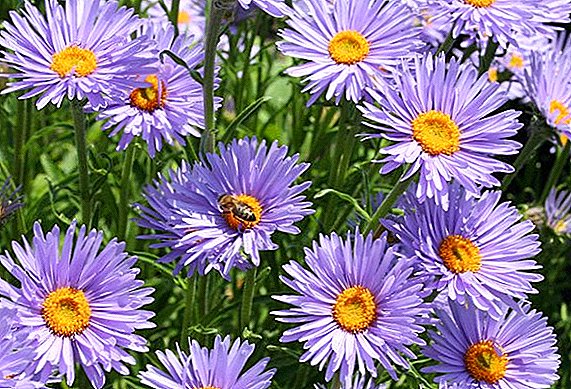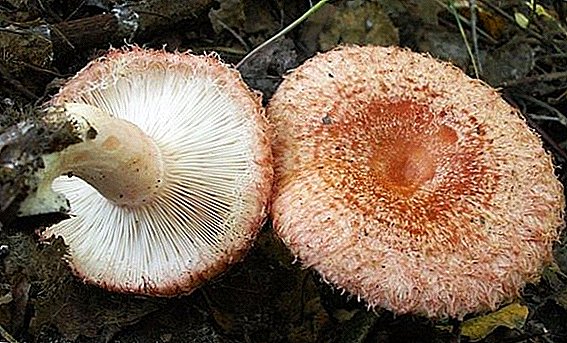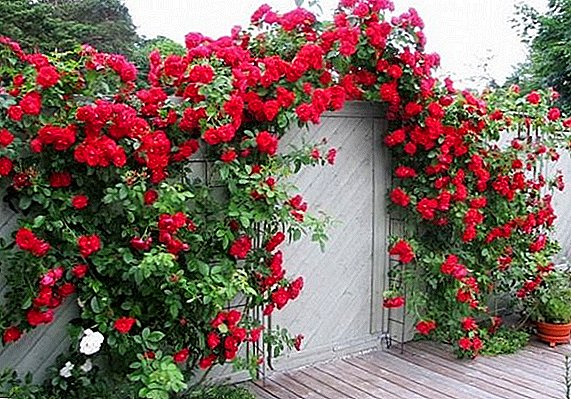 With the onset of autumn, the days are shrinking and becoming colder, and at this time the device for hibernating rose bushes should be on the list of urgent garden affairs of the grower. Of course, there are relatively cold-resistant varieties that tolerate good winter conditions. But the majority of varieties of roses are sissies and require careful shelter for the winter. In this article we will look at how to properly prepare climbing roses for wintering, what types of shelters are suitable for this, and what actions a grower should take to prepare roses for winter.
With the onset of autumn, the days are shrinking and becoming colder, and at this time the device for hibernating rose bushes should be on the list of urgent garden affairs of the grower. Of course, there are relatively cold-resistant varieties that tolerate good winter conditions. But the majority of varieties of roses are sissies and require careful shelter for the winter. In this article we will look at how to properly prepare climbing roses for wintering, what types of shelters are suitable for this, and what actions a grower should take to prepare roses for winter.
Why and when to cover climbing roses
Gardener's actions in sheltering roses for the winter depend on the climatic zone of horticulture and the types of roses grown. Hybrid and varietal climbing roses are in dire need of winter protection from the cold, especially if the air temperature drops below -15 ° C and stays at this level for a long time. 
Did you know? In 2002, the dwarf pink shrub variety "Night sensation" was brought into space to help scientists research the effects of low gravity on the floral scent. The purpose of the study was to improve the flavor for a number of consumer goods.
How to prepare the plant for winter
Stop fertilizing roses with nitrogen from late August until early spring. If the flowers will winter in the ground cover, then they need to be removed from the trellis about six weeks before the onset of frost.
Learn more about growing climbing roses; climbing roses also include such varieties as Rosarium Hütersen, Mary Rose, Abraham Derby, New Dawn, Pierre de Ronsard.
Russian winters can damage even the most resistant varieties, contribute to this:
- rapid temperature changes;
- root injuries from periodic freezing and thawing;
- damage to the bark from mouse teeth;
- injuries from ice crust.
A novice gardener needs to know that all these problems in the flower garden can be avoided if you safely and carefully planted plants. 
We take steps to prepare rose bushes for winter:
- Winter protection begins with the cessation of the supply of nitrogen fertilizers to plants from the end of August. Nitrogen encourages the growth of new shoots, which will weaken the plant and will also be less winter-hardy than the older (matured and woody) shoots. If the gardener sees that new shoots begin to grow from the base of the bush in September, they must be removed with a secateur to prevent future winter plant freezing.
- Many believe that the winter endurance of roses will increase after (at least one) autumn fertilization with potassium.
- After October 1, no longer cut flowers, allow them to bloom and turn into fruit. The development of the fruit helps to strengthen the wood bushes.
- From the beginning of September, gradually reduce the watering level. It will also help initiate the wood hardening process. Continue to monitor the soil moisture, by the end of autumn watering the bushes only as necessary, to avoid drying out of the soil. Completely stop watering the roses when the ground freezes.
- Do not trim during the shelter for the winter, except for the removal of dead, damaged and diseased branches. Wait until the end of April - this time is best suited for spring pruning of roses.

Did you know? From the Middle Ages to the present day in Italy, the expression "under the rose" is used, that is, completely secret. The image of the rose is present on the secret documents of the Illuminati in a sign that they are not subject to disclosure.
Features feeding
As mentioned above, nitrogen fertilizers no longer apply under the rose bushes at the end of the summer. Instead, you can feed the plant with root fertilizers before wintering.
Nitrogen fertilizers include ammonium nitrate, ammonium sulfate, potassium nitrate, calcium nitrate, urea.First autumn root dressing:
- 10 liters of water;
- 25 g of superphosphate;
- 10 g of potassium sulfate;
- 2.5-3.5 g of borax or boric acid.
This amount is enough to fertilize an area of 4 square meters. Top dressing is made in early September. 
Second autumn root dressing:
- 10 liters of water;
- 16 g of potassium monophosphate or potassium sulfate;
- 15 g of superphosphate.
Freshly prepared solution should be used within 10-12 hours to keep it from drying out. Usually a bucket of supplemental food is enough for 3-4 adult rose bushes. It is carried out two weeks after the first feeding.
Weed removal and debris removal
Part of the job of sheltering roses for the winter is cleaning the garden of debris, which will help prevent rose diseases in the next year:
- An important task for the grower is the removal of scraps and fragments of branches, fallen flowers and leaves, as well as other plant debris, not only after roses, but also from other plants.
- If there are other flowers in the garden (annual and wilted) that grow next to the roses, you must remove everything.
- All plant residues from the garden are removed using a rake.
- Do not leave faded roses to lie on the ground in the garden. They may contain spores of leaf diseases, such as black spots and fungus. The dead plant material is a winter shelter and dining room for insects and their larvae, as well as pathogenic microbes, which in the future will cause diseases of rose bushes. Remove debris, burn or take it out of the area. In no case do not compost such plant material - it only spreads diseases and harmful insects in the garden.

Did you know? The most expensive pink variety in the world - "Juliet", bred in 2006. Breeding this variety took 15 years and cost five million dollars.
Trimming and Hilling
In the middle or end of November, a couple of weeks before the ground freezes, the plants should be covered with 10-12 centimeters of well-drained soil. Such a mound should be spread around the roots of each flower.
This soil should be brought from another place in the garden, and not taken from the rosary. Then cover the earthen mound around the roots with another 12 to 16 centimeters of mulching material, such as straw, pine needles, or wood chips.
Learn what is and how to conduct mulching, how to mulch using sawdust.
Light upper mulch needs to be strengthened in place (from winds and downpours) with spruce or pine branches laid on top of it. You can also pin the mulch to the ground using wire "pins". 
The top layer of mulch will help stabilize the temperature of the root soil and reduce the likelihood of freezing. Additional ground cover brings warmth to the roots and lower branches of the roses, helping them to resist the icy onslaught of winter.
If the root system of the plant remains without freezing, even in case of damage to the aerial part by snow and ice, the rose bush will throw out new branches in the spring.
We carry out trimming bushes:
- Take a pruner with well-pointed blades and remove dead wood on the bushes. It is easy to distinguish it from a lively black color, it is excised until a green stalk appears. The branches are cut from the mother plant at an angle of 45 degrees, about 3 cm above the leaf bud, which faces the outside of the shrub.
- To improve air circulation and illumination inside the bush, remove all the stems that intersect and the branches growing inside the bush. Similarly, any weak and subtle growth is removed.
- The strength of the trim depends on the type of rose. For example, tea roses are cut strongly, and wickers undergo gentle pruning.

Did you know? The age of the oldest rose bush in the world is almost a thousand years. It grows against the wall of a German church in the city of Hildesheim. The mention of an ancient plant is found in the annals from 815 AD. According to the existing legend, the rosebush is a symbol of the prosperity of the native city, as long as the bush grows - the city also exists. During World War II (in 1945) the church was destroyed by bombing, but the plant survived. Its root system remained alive under the ruins of the church, and soon the bush bloomed again.
Ways to cover climbing roses
How to do it correctly and in a timely manner:
- Winter shelter for climbing roses has its own characteristics. In October, the vines are removed from the trellis and trellis. They are lowered to the ground, laid down, and pinned to the ground by a "pin" bent from thick wire. If the bush is old and overgrown, it is not so easy to do. Therefore, large bushes need to be lowered from the trellis in stages, gradually drawing them lower and lower to the ground. This can be done by tying a bucket filled with sand to the tops of the whips, which will gradually incline the bush and lay it on the ground.
- It is advisable to spread a layer of roofing material under a bush lying on the ground. (roofing material, polyethylene or wooden shield). This will prevent the frozen soil from contacting the flower stalks.
- Winter protection methods are designed to ensure that wintering plants are not affected by frost, and to prevent the destructive effects of alternating freezing and thawing cycles. Don't start covering the bushes too soon.
- Wait until most of the leaves on the roses freeze and fall off, after which you need to collect all the fallen leaves and other debris around the rose bushes. This will help avoid overwhelming fungal diseases and will be a good prevention of plant diseases next year. Burn plant garbage, do not put it in a compost pile, where in winter the temperature will not be high enough to kill disease spores. The procedure of cleansing the leaves is carried out in several stages, starting from the bottom of the bush. Leaves can be cut off even in case of frost, just before weatheating the plant. Then pin the bush to the ground and wrap it in any material that is not accessible to the mouse teeth.
- In late October or early November, before arranging a rose for the winter, remove the old mulch from the basal layer of all plants and spread out the new organic mulch, such as compost manure or peat. It helps to prevent the occurrence of diseases in the future, preserves the roots from freezing, accelerates the growth of plants in spring.
- Weaving or winding roses best hibernate when they are removed from the trellis, placed on the ground and allow the snow cover to protect them from extreme cold. If your climate zone does not allow you to count on deep snow cover in winter, you can sprinkle the soil or mulch over the lash (long branches) of the plant lying on the ground. It is also possible high shelter stems, without their prior removal from the trellis. They are left in a tied up condition on the trellis; for sheltering from frost, the plant is wrapped in several layers with a sacking and partially with polyethylene. And also, as in the case of the bush varieties, the basal zone is warmed with primer and inedible mulch for mice.
- After the mulch is frozen at the base of the bush - you need to spend the winter treatment of roses (treatment with special chemicals) to prevent the development of future fungal diseases.
- To hold the snow on the structure, you can make shields and strengthen the entire structure laid over the bricks. Spruce and pine branches are designed not only for warming, but also to prevent the appearance of rodents that do not tolerate the smell of pine needles. Along the perimeter of the rose garden, the grower can spread out poisonous baits for rodents.
- Shelter over tall rose bushes should be erected gradually, its side openings should remain open until severe frosts. They are completely sealed only after the temperature has decreased to -5 ... -10 ° C.

Important! If there are mice in the garden, then it is better not to lay the upper mulch layer of sawdust or straw, as the mice happily spend the winter in the shelter provided to them, damaging the roots and trunk of the rose bushes along the way.
With the construction of the frame
Building shelters for strolling roses is especially important in areas where it is freezing in winter, but there is little snow. It is possible to build a wooden frame on which a heat-insulating coating is subsequently put. For example, you can put fir branches on the frame, and on top of them - plastic film to protect against moisture.
What materials can be used as a heater:
- slate;
- wooden shields;
- ruberoid;
- polyethylene;
- wooden and plastic boxes;
- plastic flower pots;
- carton boxes;
- spruce or pine branches.

Did you know? The world's largest rose bush - white "Lady Banksia", growing in Arizona (USA). The rose bush has grown over a gazebo that is over nine thousand square feet.
Without frame
Wintering roses require special attention. Experienced rose growers recommend to be sure to remove them from poles, lay them on the ground and cover them with heat-storage materials, but this is not very convenient for most home gardens.
Instead, you can collect the tips of the long branches of the woven rose and wrap them in burlap (several layers), using twine to secure the insulation. Be sure to fill the soil at the base of the plant and this securely cover the roots with mulch.
If the gardener cannot keep track of the roses all the time (due to living elsewhere), then tall bushes from October are laid on the ground, and the root zone is generously mulched with compost.  Enough three buckets of land to fully protect the bush from frost. It is better to prepare the soil for warming the bush in advance and store it under cover in a dry form so that it does not get wet and therefore does not freeze (which will make its use as a root shelter impossible).
Enough three buckets of land to fully protect the bush from frost. It is better to prepare the soil for warming the bush in advance and store it under cover in a dry form so that it does not get wet and therefore does not freeze (which will make its use as a root shelter impossible).
The soil is perfect for sheltering the roots, since, for example, sand does not retain heat and the roots will freeze, and basal shelter with sawdust is dangerously possible development of fungal diseases and mold.
If deep snow has fallen and the temperature outside is very low, there is no cause for concern, because the snow layer reliably protects the plants from freezing.
Important! Check the grille or other supporting structure, standing side by side, for stability to ensure its strength. If snow or wind blows a trellis in winter, it can easily break the woven rose lying on the ground and damage it.

When and how to remove shelter
With the onset of spring, the gardener should not rush to remove the winter shelter from the rose bushes:
- if the air temperature has risen, the sun is shining in the sky, but the ground has not yet warmed up, then the buds that are early in the growth do not find the necessary moisture. In addition to all, the bush has lost the habitat of the sun for many months, and young leaves that have started growing can suffer from "physiological drought";
- However, it is also impossible to overtighten with the removal of the winter shelter from the plant. As soon as the positive temperatures become constant, and spring will establish itself in its rights, the radical mounds artificially filled in the fall from the soil and mulch scrape to the sides, allowing the roots to become saturated with oxygen. Also during this period, the upper part of the shelter of weaving roses is opened;
- remove the mulch and feed the bushes with a good fertilizer for the pink family. These flowers are very sensitive to regular fertilization, so spring dressing is obligatory;
- during the "February window" (thaw) flowers can bloom. The same trouble threatens the bushes too early at the beginning of winter, as there is always the likelihood of temperature fluctuations from frost to thaw. In addition, the chances of survival of flowers in winter will increase if their young wood hardens in the air (without shelter) before the onset of frost.

Sheltering roses for the winter looks quite challenging, but if the rosary is not too large, it will not take long.
Fortunately, roses only look quivering and delicate - their fragrance and beautiful flowers hide a strong and durable bush. Most of the roses, covered with the gardener's careful hands, will survive in the winter with minimal losses.












